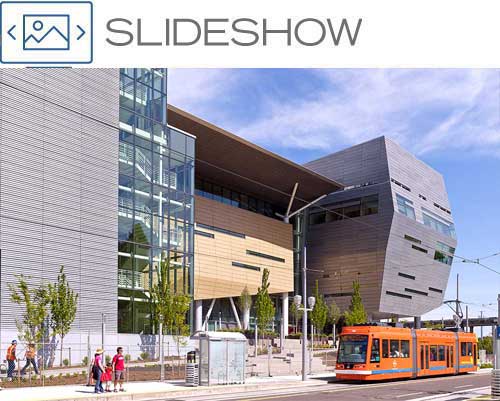Student-centric design in simulation centers
Much is said in public discourse about revolutionary medical treatments, groundbreaking technologies and patient outcomes. But how are medical schools providing future doctors the education they need to keep up with these evolving realities? By advancing medical education pedagogy through team-based learning and early, integrated clinical exposure, universities are able to respond to current medical advancements while remaining viable into the future.
Physical space, however, has been lagging to accommodate this change. To keep up with the realities of health care, the academic medical world must re-envision its learning facilities as a tool to support ongoing reforms in medical education. As medical school curricula have shifted away from knowledge acquisition via repetitive memorization, and become increasingly reliant on technology, traditional lecture halls and wet science laboratories have become obsolete. Instead, many schools emphasize the clinical application of medical knowledge and the development of critical-thinking skills. This approach requires spaces that support small-group discussion, problem-based learning, and hands-on clinical skills training much earlier in the curriculum.
The contemporary medical education building is arguably a new, distinct facility type. It encompasses a holistic environment to support both formal and informal learning, embodies principles of health and wellness, and houses a broad spectrum of technology-enhanced classrooms, learning studios, clinical training spaces and community-life functions.
Over the past 10 years, CO Architects has been an active player in this arena. It has completed five medical and health education buildings nationally, with seven more underway. Borrowing from its patient-centric health care design experience, the group’s medical education work has been driven by student-centric design.
Student-centric design relies on evidence and feedback from learners to help ensure that the building’s program, configuration and features support their needs, the curriculum and the pedagogical vision for the institution. In addition, the most successful facilities go beyond the classroom and dedicate significant program space and features to support healthy behaviors, respite areas and serendipitous meetings. Projects that follow this framework have created communities of exchange and discovery that are vital to modern medical teaching.
By nature, medical simulation facilities are meant to mirror real-life inpatient spaces, operating rooms,and ambulatory settings. These experientially immersive environments promote critical thinking and teamwork, as students interact with sophisticated,full-body simulation mannequins that provide real-time physiological responses and feedback, making it a powerful tool for hands-on training before, during and after learners are introduced to actual clinical settings and patients.
The Collaborative Life Sciences Building in Portland, Ore., exemplifies an innovative model that merges interprofessional health sciences education with research and clinical functions through the concept of “health science on display.” The building does so in the form of a steel-and-glass, 12-story complex with 500,000 square feet of space for research and teaching. A state-of-the-art medical simulation center accommodates collaborative, clinical team training across disciplines for practitioners, students, and staff from several of the health professions to train side by side.
The Health Sciences Education Building at the University of South Carolina’s School of Medicine, Greenville, features an innovative curriculum that interweaves clinical experiences with team-based learning. A cornerstone of the facility is the Greenville Healthcare Simulation Center, which bridges pedagogy with practice to service both the medical school and the upstate region of South Carolina. The interprofessional facility, located on the main campus of the Greenville Hospital System, supports programs in medicine, pharmacy and nursing.
The Houston Methodist Institute for Technology, Innovation & Education — a cutting-edge facility located within one floor of the Methodist Hospital Research Institute — houses a virtual hospital, procedural training suite and research core to provide opportunities for the development of collaborative, cutting-edge research and training. It also includes an interoperative MRI suite, a CT scan operating room and two robotic surgery operating rooms to improve patient safety. An interactive, high-tech theater, equipped with advanced technology from ImageStream Medical, allows students, doctors and educators to observe procedures occurring in real time inside actual surgical environments and simulation areas.
These advanced, technology-driven learning environments place students together to prepare them for working collaboratively in the real world. With simulation training, students are able to practice high-risk activities in low-risk settings and to problem-solve both common and uncommon scenarios.
Furthermore, students have the opportunity to practice doctor-patient scenarios (with live actors or “standardized patients”) to help improve their interpersonal and diagnosing skills. With proper clinical training, supported by state-of-the-art medical education facilities, academic medical facilities can prepare the next generation of physicians, nurses and allied health professionals for the challenges and complexities they will face in an ever-changing health care system.
Jonathan Kanda, AIA, LEED AP BD+C, is a principal at CO Architects, a Los Angeles-based architecture, interior design and planning firm specializing in institutional projects nationwide. Email inquiries@coarchitects.com for more information





